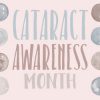A report from Prevent Blindness America found that over 24 million U.S. residents who are 40-years-old and up have cataracts. This disease is the number one reason people go blind, and contributes to other negative health factors like an increased risk of falls. June is Cataract Awareness Month. You can learn more about this optical health issue below.
What are cataracts?
Cataracts occur when the lens of the eye becomes cloudy. This interrupts the person’s vision because light is no longer able to travel through the pupil and onto the retina like it should. Those who have cataracts may also experience blurry or dim vision that happens in one or both of their eyes. The visual effects of cataracts may be like looking through a dirty window. The American Academy of Ophthalmology noted that cataracts develop slowly, and individuals who have them might not notice the condition at first. Without regular eye doctor appointments, a person may not realize he or she has cataracts until the condition becomes too severe to address medically.

How are cataracts treated?
Some people can treat their cataracts through surgery, where the cloudiness is removed. Then, an intraocular lens, also known as an IOL, is implanted in its place. The lens is clear and acts like a natural lens, allowing for better light flow through the eye. For less severe cataracts, eye doctors may simply alter a patient’s glasses prescription to account for lost vision.
Who is at risk for cataracts?
Both males and females may develop cataracts. Older adults are at a particularly high likelihood of developing these optical disruptions because they tend to happen with age. People who have diabetes, drink a lot of alcohol, have high blood pressure or who are obese may also have a higher likelihood of having cataracts. Previous injury to the eye, optical inflammation or eye surgery can further increase the risk. Smokers, people who have had radiation therapy for cancer or who have been exposed to sunlight much more than normal are more likely to develop cataracts too. Recognize Cataract Awareness Month by scheduling an appointment with your eye doctor to make sure you’re on top of your optical health.
If you found an error, highlight it and press Shift + Enter or click here to inform us.



